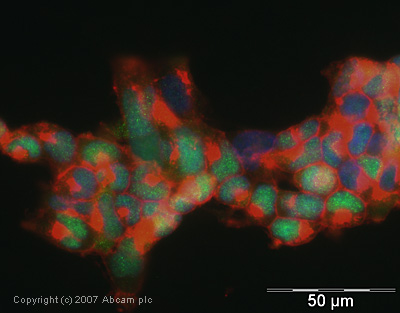Anti-XLF antibody
| Name | Anti-XLF antibody |
|---|---|
| Supplier | Abcam |
| Catalog | ab33499 |
| Prices | $380.00 |
| Sizes | 100 µg |
| Host | Rabbit |
| Clonality | Polyclonal |
| Isotype | IgG |
| Applications | IP IHC-P ICC/IF ICC/IF WB |
| Species Reactivities | Human, Dog |
| Antigen | Synthetic peptide derived from within residues 250 - 350 of Human XLF1 |
| Description | Rabbit Polyclonal |
| Gene | NHEJ1 |
| Conjugate | Unconjugated |
| Supplier Page | Shop |
Product images
Product References
Canonical non-homologous end joining in mitosis induces genome instability and is - Canonical non-homologous end joining in mitosis induces genome instability and is
Terasawa M, Shinohara A, Shinohara M. PLoS Genet. 2014 Aug 28;10(8):e1004563.
A new method for high-resolution imaging of Ku foci to decipher mechanisms of DNA - A new method for high-resolution imaging of Ku foci to decipher mechanisms of DNA
Britton S, Coates J, Jackson SP. J Cell Biol. 2013 Aug 5;202(3):579-95.
XRCC4's interaction with XLF is required for coding (but not signal) end joining. - XRCC4's interaction with XLF is required for coding (but not signal) end joining.
Roy S, Andres SN, Vergnes A, Neal JA, Xu Y, Yu Y, Lees-Miller SP, Junop M, Modesti M, Meek K. Nucleic Acids Res. 2012 Feb;40(4):1684-94.
BCR/ABL stimulates WRN to promote survival and genomic instability. - BCR/ABL stimulates WRN to promote survival and genomic instability.
Slupianek A, Poplawski T, Jozwiakowski SK, Cramer K, Pytel D, Stoczynska E, Nowicki MO, Blasiak J, Skorski T. Cancer Res. 2011 Feb 1;71(3):842-51.

![XLF was immunoprecipitated using 0.5mg A431 whole cell extract, 5µg of Rabbit polyclonal to XLF and 50µl of protein G magnetic beads (+). No antibody was added to the control (-). The antibody was incubated under agitation with Protein G beads for 10min, A431 whole cell extract lysate diluted in RIPA buffer was added to each sample and incubated for a further 10min under agitation.Proteins were eluted by addition of 40µl SDS loading buffer and incubated for 10min at 70oC; 10µl of each sample was separated on a SDS PAGE gel, transferred to a nitrocellulose membrane, blocked with 5% BSA and probed with ab33499.Secondary: Mouse monoclonal [SB62a] Secondary Antibody to Rabbit IgG light chain (HRP) (ab99697).Band: Bands: 35kDa: XLF; non specific - 37kDa: We are unsure as to the identity of this extra band.](http://www.bioprodhub.com/system/product_images/ab_products/2/sub_5/21882_XLF-Primary-antibodies-ab33499-12.jpg)


